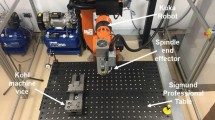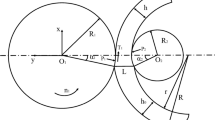Abstract
To answer an increasing need for glass product manufacturing in both small and medium series, the first glass-blower robot was recently developed. In the face of this new technology, which particularly interests crystal glass-makers, expertise remains the main decision-making element which intervenes in the choices of the design and implementation of these new processes. Finite element models of this new blowing process were developed. After the analysis of the process and of these stages, an initial sensibility study allowed us to find the essential parameters for the success of the operation. With the results of these sensitivity analyses, an optimizer was developed to adjust virtually the forming process of a linear cylindrical vase by determining the optimal forming parameters. A second optimization allowed us to determine the initial shape of the parison, an essential parameter in the successful forming of a convex cylindrical vase. Finally, the numerical tools were validated during trial campaigns carried out in crystal glass-makers.





Similar content being viewed by others

Abbreviations
- A s i :
-
normalized functions n s i
- C 1 :
-
constraint equation
- E ( p i ):
-
error function
- ep s * :
-
vase thickness obtained by finite element models
- \( {\mathop {ep_{s} }\limits^ \wedge } \) :
-
prescribed designer’s vase thickness
- \( f^{{ * s}}_{m} {\left( {p^{s}_{0} + \Delta p^{s}_{i} } \right)} \) :
-
glass distribution calculated in a point m after disturbing
- \( {\mathop {f^{s}_{m} }\limits^ \wedge }{\left( {p^{s}_{0} } \right)} \) :
-
glass distribution obtained in a point m
- G :
-
first derivative of the penalization function ξ j ( p)
- H :
-
second derivative of the penalization function ξ j ( p)
- I :
-
identity matrix
- J :
-
Jacobian matrix of the error function E ( p i )
- M :
-
number of comparison points
- m :
-
point of the vase
- N s :
-
number of parameters
- n s i :
-
standardized functions of N s variations
- P s 1 :
-
pressure of free blowing
- p s i :
-
ith parameter p s
- T init :
-
initial temperature after reheating
- t f 2 :
-
time of vertical creep
- t m :
-
time of first shaping
- t s 1 :
-
time of free blowing
- α 1 :
-
angle of tilted creep
- λ :
-
Levenberg–Marquardt parameter
- ω 1 :
-
positive scalar
- ξ j ( p):
-
penalization function
References
Cormeau A, Cormeau I, Roose J (1984) Numerical simulation of glass blowing in numerical analysis of forming processes. In: Pittman JFT, Zienkiewicz C, Wood RD, Alexander JM (eds) Numerical analysis of forming processes. Wiley, New York, pp 219–238
Tateishi S, Sasaki S, Kobayashi T (1991) Coupled thermal-stress analysis of glass blowing process. In: Proceeding of the international conference on computational engineering science, Melbourne, Australia
Cesar De Sa JMA (1986) Numerical modelling of glass forming processes. Eng Comput 3:266–275
Lochegnies D, Noiret C, Oudin J (1996) A computing procedure for the temperature in the glass. Application to the finite element analysis of the hollow glass forming. Glastechnische Berichte Glass Sci Technol 69:253–264
Anderson HJ, Liu GQ, Owen DRJ (1992) Computational approaches to the design and forming simulation of glass containers. Klei Glas Keramiek 13:150–153
Rekhson SM, Wang Y, Wang HP (1990) Computer modelling of glass flow in ribbon process. Ceram Eng Sci Proc 11:196–204
Rekhson S, Lu ZH (1993) Computer modelling of the forming process. The Glass Industry 74:15–19
Lochegnies D, Wiertel P, Narayanaswamy OS (1999) Inverse determination of material properties and optimization of flat glass tempering. Int J Forming Processes 2:95–116
Lochegnies D, Marion C, Carpentier E, Oudin J (1996) Finite element contributions to glass manufacturing control and optimisation. 2. Blowing, pressing and centrifuging of hollow items. Glass Technol 37:169–174
Moreau P, Lochegnies D, Oudin J (1999) Optimum tool design for flat glass pressing. Int J Forming Processes 2:81–94
Moreau P, Marechal C, Lochegnies D (2001) Optimum parison shape for glass blowing. In: Proceedings of XIXth international congress on glass, Edinburgh, Scotland pp 548–549
Caroll CW (1961) The created response surface technique for optimizing nonlinear restrained systems. Operations Res 9:169–184
Schnur DS, Zabaras N (1992) An inverse method for determining elastic material properties and a material interface. Int J Numer Methods Eng 33:2039–2057
Sharp DE, Ginther LB (1951) Effect of composition and temperature on the specific heat of glass. J Am Ceram Soc 34:260–271
Primenko VI (1980) Theoretical method of determining the temperature dependence of the thermal conductivity of glasses. Steko i Keramike 5:17–18
Van Zee AF, Babcock CL (1951) A method for the measurement of thermal diffusivity of molten glass. J Am Ceram Soc 34:244–250
Marquardt DW (1963) An algorithm for least squares estimation of nonlinear parameters. J Soc Indust Appl Math 11:431–440
Acknowledgements
The present work is supported by the CNRS, the European Community, the Ministère de L’Education Nationale et de la Recherche, the Laboratoire d’Automatique, de Mécanique et d’Informatique Industrielles et Humaines, the Cyberglass Robotics Company and the Rogaska Crystal manufacturer (Slovenia) . The authors gratefully acknowledge the support of the institutions.
Author information
Authors and Affiliations
Corresponding author
Appendices
Appendix 1. Set of material properties for numerical modeling of rheological testing
The set of glass material properties used for the process modeling are indicated in the Table 4. The set of glass material properties is proposed by:
The viscosity and the convection coefficient with the ambient air were determined by two characterization tests developed by the “Modeling of Glass Forming and Tempering “ team of the L.A.M.I.H. of Valenciennes (Fig. 6). The mould material properties (wood) are recapitulated in the Table 5. The initial mould temperature was 150°C.
Heat transfer coefficient between the glass and the mould as a function of the contact time proposed by Cesar De Sa [3]
Appendix 2. Inverse method and optimization procedure
The identification method used is based on an iterative diagram in three stages. The aim is to determine N parameters p i in order to reduce the difference between the objective solution \( {\mathop f\limits^ \wedge } \) and the numerical solution f * ( p i ). The error function E to be minimized is expressed by:
with
where M is the number of comparison points.
Constraints can be added to limit the identified parameters to a field of validity by penalizing the error function. These constraints C j ( p i ) are expressed by
where q represents the number of constraints.
The rewritten error function is then:
with
where ξ j ( p i ) is the penalization function suggested by Caroll [12], and ω j ( p i ) a positive scalar of penalization that Schnur [13] proposes to determine by
When the initial parameters are chosen the identification can begin. The resolution uses an algorithm developed by Levenberg–Marquardt [13]. At the k th iteration, the dp i corrections added to the p i parameters are expressed by:
where λ is the Levenberg–Marquardt parameter. The Jacobian matrix J of the error function E ( p i ), G and H the first and second derivatives, respectively, of the penalization function ξ j ( p) are expressed by:
where J si (the terms of the Jacobian matrix) are approximated by finite differences. A coefficient of sensitivity S p is added to the algorithm for the calculation of the partial derivative of each parameter:
The Levenberg–Marquardt parameter λ determines simultaneously the direction and the size of the dp correction. Marquardt showed that if this parameter tends to the infinite, the direction will take the greatest slope and the step of correction will be smaller [17].
The determination of the solution ( p 1,..., pn) that minimizes the error function E ( pi) is made with the algorithm
-
1.
Determine the initial values of the parameters to identify p i (0), the sensitivity S p and the Levenberg–Marquardt parameter λ (0).
-
2.
Calculate the numerical solution of the problem f * ( p i (0)) and determine the error function E (0).
-
3.
Determine the initial constraint function ξ j (0) and the error function E *(0).
-
4.
For an iteration k ≥1:
- (a):
-
Calculate the Jacobian matrix J ( k) by solving an approximation by finite differences.
- (b):
-
Calculate the first derivative H ( k) and the second G ( k) of the constraint function.
- (c):
-
Determine the parameter corrections dp i ( k) by the resolution of Eq. (14) p i ( k +1)= p i ( k)+dp i ( k).
- (d):
-
Calculate the numerical solution of the problem f* (pi (k +1)), the constraint function ξ j ( k +1) and the error function E *( k +1).
- (e):
-
Check the convergence of the solution E *( k +1)< E *( k). If the convergence is checked and if the error is lower than the stop criteria, the identification is finished. If the convergence is checked and if the error is higher than the stop criteria, the identification goes on (stage f). If the convergence is not checked, multiply the Levenberg–Marquardt parameter by 10 ( λ ( k)=10 λ ( k)) and begin again at stage (c).
- (f):
-
Reduce the weight factors ω j ( p i )( k) and λ ( k), increment k to 1, begin again at stage (a).
Rights and permissions
About this article
Cite this article
Marechal, C., Moreau, P. & Lochegnies, D. Numerical optimization of a new robotized glass blowing process. Engineering with Computers 19, 233–240 (2004). https://doi.org/10.1007/s00366-003-0263-1
Received:
Accepted:
Published:
Issue Date:
DOI: https://doi.org/10.1007/s00366-003-0263-1




